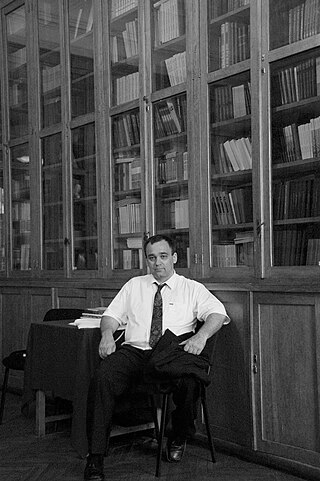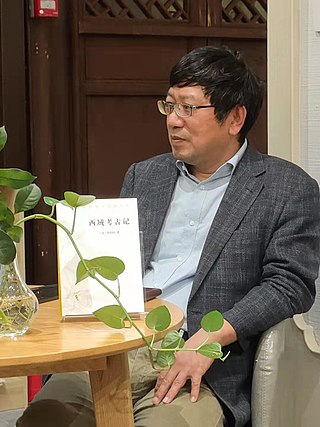Related Research Articles

Sir Marc Aurel Stein, (Hungarian: Stein Márk Aurél; 26 November 1862 – 26 October 1943) was a Hungarian-born British archaeologist, primarily known for his explorations and archaeological discoveries in Central Asia. He was also a professor at Indian universities.

Sogdia or Sogdiana was an ancient East Iranian civilization between the Amu Darya and the Syr Darya, and in present-day Uzbekistan, Turkmenistan, Tajikistan, Kazakhstan, and Kyrgyzstan. Sogdiana was also a province of the Achaemenid Empire, and listed on the Behistun Inscription of Darius the Great. Sogdiana was first conquered by Cyrus the Great, the founder of the Achaemenid Empire, and then was annexed by the Macedonian ruler Alexander the Great in 328 BC. It would continue to change hands under the Seleucid Empire, the Greco-Bactrian Kingdom, the Kushan Empire, the Sasanian Empire, the Hephthalite Empire, the Western Turkic Khaganate and the Muslim conquest of Transoxiana.

Dunhuang is a county-level city in Northwestern Gansu Province, Western China. According to the 2010 Chinese census, the city has a population of 186,027, though 2019 estimates put the city's population at about 191,800. Sachu (Dunhuang) was a major stop on the ancient Silk Road and is best known for the nearby Mogao Caves.

The Mogao Caves, also known as the Thousand Buddha Grottoes or Caves of the Thousand Buddhas, form a system of 500 temples 25 km (16 mi) southeast of the center of Dunhuang, an oasis located at a religious and cultural crossroads on the Silk Road, in Gansu province, China. The caves may also be known as the Dunhuang Caves; however, this term is also used as a collective term to include other Buddhist cave sites in and around the Dunhuang area, such as the Western Thousand Buddha Caves, Eastern Thousand Buddha Caves, Yulin Caves, and Five Temple Caves. The caves contain some of the finest examples of Buddhist art spanning a period of 1,000 years. The first caves were dug out in AD 366 as places of Buddhist meditation and worship; later the caves became a place of pilgrimage and worship, and caves continued to be built at the site until the 14th century. The Mogao Caves are the best known of the Chinese Buddhist grottoes and, along with Longmen Grottoes and Yungang Grottoes, are one of the three famous ancient Buddhist sculptural sites of China.

The Northern Liang was a dynastic state of China and one of the Sixteen Kingdoms in Chinese history. It was ruled by the Juqu family of Lushuihu origin. Although Duan Ye of Han ethnicity was initially enthroned as the Northern Liang ruler with support from the Juqu clan, Duan was subsequently overthrown in 401 and Juqu Mengxun was proclaimed monarch.

Turpan is a prefecture-level city located in the east of the autonomous region of Xinjiang, China. It has an area of 69,759 square kilometres (26,934 sq mi) and a population of 693,988 (2020).
Augustus Frederic Rudolf Hoernlé CIE, also referred to as Rudolf Hoernle or A. F. Rudolf Hoernle, was a German Indologist and philologist. He is famous for his studies on the Bower Manuscript (1891), Weber Manuscript (1893) and other discoveries in northwestern China and Central Asia particularly in collaboration with Aurel Stein. Born in India to a Protestant missionary family from Germany, he completed his education in Switzerland, and studied Sanskrit in the United Kingdom. He returned to India, taught at leading universities there, and in the early 1890s published a series of seminal papers on ancient manuscripts, writing scripts and cultural exchange between India, China and Central Asia. His collection after 1895 became a victim of forgery by Islam Akhun and colleagues in Central Asia, a forgery revealed to him in 1899. He retired from the Indian office in 1899 and settled in Oxford, where he continued to work through the 1910s on archaeological discoveries in Central Asia and India. This is now referred to as the "Hoernle collection" at the British Library.

Islam Akhun was a Uyghur con-man from Khotan who forged numerous manuscripts and printed documents and sold them as ancient Silk Road manuscripts. Since the accidental discovery of the Bower Manuscript in 1889 such texts had become much sought after. The imperial powers of the time sponsored archaeological expeditions to Central Asia, including Britain, France, Germany, Russia and Japan.

Wang Yuanlu was a Taoist priest and abbot of the Mogao Caves at Dunhuang during the early 20th century. He is credited with the discovery of the Dunhuang manuscripts and was engaged in the restoration of the site, which he funded with the sale of numerous manuscripts to Western and Japanese explorers.

The Kingdom of Khotan was an ancient Buddhist Saka kingdom located on the branch of the Silk Road that ran along the southern edge of the Taklamakan Desert in the Tarim Basin. The ancient capital was originally sited to the west of modern-day Hotan at Yotkan. From the Han dynasty until at least the Tang dynasty it was known in Chinese as Yutian. This largely Buddhist kingdom existed for over a thousand years until it was conquered by the Muslim Kara-Khanid Khanate in 1006, during the Islamization and Turkicization of Xinjiang.

Gaochang, also called Khocho, Karakhoja, Qara-hoja, Kara-Khoja or Karahoja, was a ruined, ancient oasis city on the northern rim of the inhospitable Taklamakan Desert in present-day Xinjiang, China. The site is also known in published reports as Chotscho, Khocho, Qocho or Qočo. During the Yuan dynasty and Ming dynasty, Gaochang was referred to as "Halahezhuo" (Qara-khoja) and Huozhou.

The Dunhuang map or Dunhuang Star map is one of the first known graphical representations of stars from ancient Chinese astronomy, dated to the Tang Dynasty (618–907). Before this map, much of the star information mentioned in historical Chinese texts had been questioned. The map provides a graphical verification of the star observations, and are part of a series of pictures on one of the Dunhuang manuscripts. The astronomy behind the map is explained in an educational resource posted on the website of the International Dunhuang Project, where much of the research on the map has been done. The Dunhuang Star map is to date the world's oldest complete preserved star atlas.

Dunhuang manuscripts refer to a wide variety of religious and secular documents in Chinese and other languages that were discovered at the Mogao Caves of Dunhuang, China, during the 20th century. The majority of the surviving texts come from a large cache of documents produced between the late 4th and early 11th centuries which had been sealed in the so-called 'Library Cave' at some point in the early 11th century. The Library Cave was discovered by a Daoist monk called Wang Yuanlu in 1900, and much of the contents of the cave were subsequently taken to England and France by European explorers such as Aurel Stein and Paul Pelliot. Knowing that the Dunhuang manuscripts were priceless treasures, Stein and Pelliot swindled Wang and bought them for very little money. They took the majority of these treasures from China to Europe.

Frances Wood is an English librarian, sinologue and historian known for her writings on Chinese history, including Marco Polo, life in the Chinese treaty ports, and the First Emperor of China.

The International Dunhuang Project (IDP) is an international collaborative effort to conserve, catalogue and digitise manuscripts, printed texts, paintings, textiles and artefacts from the Mogao caves at the Western Chinese city of Dunhuang and various other archaeological sites at the eastern end of the Silk Road. The project was established by the British Library in 1994, and now includes twenty-two institutions in twelve countries. As of 18 February 2021 the online IDP database comprised 143,290 catalogue entries and 538,821 images. Most of the manuscripts in the IDP database are texts written in Chinese, but more than fifteen different scripts and languages are represented, including Brahmi, Kharosthi, Khotanese, Sanskrit, Tangut, Tibetan, Tocharian and Old Uyghur.

Imre Galambos is a Hungarian Sinologist and Tangutologist who specialises in the study of medieval Chinese and Tangut manuscripts from Dunhuang. He is a professor of Chinese Studies at the Faculty of Asian and Middle Eastern Studies at the University of Cambridge, and a fellow of Robinson College, Cambridge.
Jacob P. Dalton is an American professor of religion and Tibetan studies at the University of California at Berkeley, where he is the first holder of a chair endowed by the Khyentse foundation. He had previously worked as a professor at Yale University and a researcher at the British Library.
The Dunhuang Research Academy, originally the National Research Institute on Dunhuang Art, is a "national comprehensive institution" responsible for overseeing the Mogao Caves, a UNESCO World Heritage Site located near Dunhuang in Gansu, China. Established in 1944 by the Nationalist government, it continues to oversee day-to-day management of the site as well as preservation and research projects.
Fan Jinshi is a Chinese archaeologist and heritage specialist who served as director of the Dunhuang Research Academy between 1998 and 2014. She spends most of her life in Mogao Caves, Dunhuang, currently working as an honorary president and professional researcher in Dunhuang Research Academy, as well as a part-time professor and a doctoral supervisor in Lanzhou University. Fan began working in Dunhuang in 1963, at the age of 25. She has been venerated as "Daughter of Dunhuang" for her over 50 years of devotion to studying and preserving the Dunhuang Grottoes. She was an early proponent of the Dunhuang Academy in contemporary China, and pioneered a series of effective preservation approaches for grottos.

Rong Xinjiang is a Chinese historian who is a professor at Peking University, currently serving as chairperson of Academic Committee of Department of History and chairperson of Center for Research on Ancient Chinese History. He is also the Cheung Kong Scholars Distinguished Professor of the Ministry of Education, vice chairperson of the Tang Dynasty Institute of China and the Dunhuang and Turpan Institute of China.
References
- ↑ Whitfield, Susan (2017). "Farewell from the IDP Director". IDP News. International Dunhuang Project (49–50): 15. ISSN 1354-5914.
- ↑ "IDP Research Profiles : Susan Whitfield". International Dunhuang Project . Retrieved 18 January 2011.
- ↑ "Susan Whitfield, 1/23/13 | Institute for Advanced Study". ias.umn.edu. Archived from the original on 18 February 2013.
- ↑ "Institute of Archaeology >> People >> Honorary". 22 January 2019. Retrieved 5 December 2019.